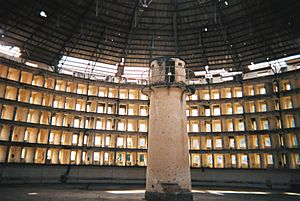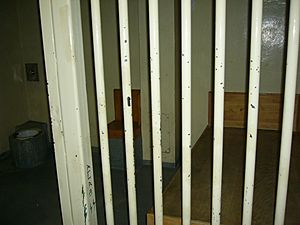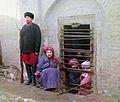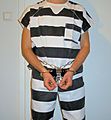Prison facts for kids
A prison (also called a jail or gaol) is a special building where people who have broken the law are kept. It's a place where they are held against their will. Some people stay in prison for a long time, even for their whole lives, after being found guilty of a serious crime. Others might be there for a shorter time, perhaps while they wait for their case to be heard in court. Jails are often for shorter stays or for people waiting for trial.
Prisons are usually run by the government. You might hear them called other names like "penitentiary," "jail," or "correctional facility." There are different kinds of prisons, like regular prisons, special prisons for people on "death row" (those sentenced to death), or "maximum security" prisons for very dangerous people.
People in prison often wear special uniforms. These uniforms can be bright colors like orange, blue, or green. The color might depend on the prison or what kind of work the person does inside the prison. For example, some prisoners who work might wear orange, while others with more serious records might wear red.
Contents
Why People Go to Prison
People can be sent to prison for different reasons.
Before a Trial
Sometimes, a person might be sent to prison even before they are found guilty of a crime. This can happen if:
- The police have arrested them and are deciding if they should go to court.
- The court thinks the person might not show up for their trial.
- The court believes the person could be a danger to the community if they are not held.
- The court has asked for bail (money paid to ensure someone returns for trial), but the person cannot pay it.
After Being Found Guilty
If a person is found guilty of a crime by a court, they are called a convict. They will then be sentenced to prison as a punishment for what they did.
Other Reasons
In some countries, prisons are also used to hold political prisoners. These are people who disagree with the country's leaders or government. During times of war, prisoners of war (soldiers captured by the enemy) might also be held in prisons.
People held in prisons are called inmates or prisoners.
Images for kids
-
A zindan (a traditional Central Asian prison) in Russia, photographed between 1905 and 1915.
-
In Early Modern Europe, a common punishment was to be made a galley slave. This galley belonged to the Mediterranean fleet of Louis XIV, around 1694.
-
The convict ship HMS Discovery served as a convict hulk (a floating prison) between 1818 and 1834.
-
Jeremy Bentham's "panopticon" prison design from 1791. It allowed guards in a central tower to see all prisoners without being seen themselves.
-
Shita (Shata) Prison in Israel. Many modern prisons have high walls, razor wire, and guard towers to prevent escapes.
-
ADX Florence is a Supermax prison in the Federal Bureau of Prisons in the U.S.
-
An inmate teaching other inmates in Kenya.
-
Captives at Camp X-Ray, Guantanamo Bay, Cuba, a United States military prison (January 2002).
-
A memorial to the prison staff who died in the 1971 riot at Attica Correctional Facility.
See also
 In Spanish: Prisión para niños
In Spanish: Prisión para niños



















